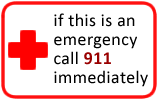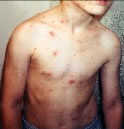Chickenpox
Chickenpox
Does this describe your child's symptoms? |
Click image for more info |
Definition
Symptoms
Cause
Return to School
|
If not, see these topics
|
When to Call Your Doctor |
Call 911 Now (your child may need an ambulance) If |
|
|
|
Call Your Doctor Now (night or day) If |
|
|
|
Call Your Doctor Within 24 Hours (between 9 am and 4 pm) If |
|
|
|
Call Your Doctor During Weekday Office Hours If |
|
|
|
Parent Care at Home If |
|
|
HOME CARE ADVICE FOR CHICKENPOX |
Cool Baths: For itching, give cool or lukewarm baths for 10 minutes as often as needed (caution: avoid any chill). Can add baking soda 2 ounces (60 ml) per tub. Baths don't spread the chickenpox.
Calamine Lotion: Apply calamine lotion to the chickenpox that itch the most or massage them with an ice cube for 10 minutes (Don't use any lotion containing Benadryl because it can be absorbed across the inflamed skin and cause side effects).
Benadryl Medicine: If itching becomes severe or interferes with sleep, give oral Benadryl (see Dosage table).
Discourage Scratching: Trim fingernails and wash hands frequently with an antibacterial soap to prevent impetigo (infected sores). Discourage picking and scratching.
Fever Medicine:
Give acetaminophen (e.g., Tylenol) for fever above 102° F (39° C)
Never use aspirin (Reason: risk of Reyes syndrome)
Also don't use ibuprofen (Reason: may increase risk of severe strep skin infections)
Soft Diet: Offer a soft diet for painful mouth and throat ulcers. For infants, give fluids by cup, spoon, or syringe rather than bottle because the nipple can cause increased pain.
Liquid Antacid for Mouth Pain: For severe mouth ulcers in children over age 4, use 1 teaspoon (5 ml) of a liquid antacid as a mouth wash 4 times per day after meals. For younger children, put a few drops in the front of the mouth after meals.
Painful Urination:
For females with painful vulva ulcers, apply petroleum jelly to the area as needed.
For severe pain, use a numbing ointment such as 2.5% xylocaine ointment (no prescription needed) 4 times per day.
For males with painful pox on the tip of the penis, this also works.
Contagiousness: Your child can return to child care or school after all the sores have crusted over, usually day 6 or 7 of the rash.
Expected Course: Expect new chickenpox every day for 4 or 5 days. Most children get 400 to 500 chickenpox.
Preventing Exposure of Office to Chicken Pox: If need to be seen, consider bringing 2 adults and having one enter office first for instructions. For nonemergent problems, doctor may examine child in the car.
Call Your Doctor If:
Chickenpox look infected (draining pus, scabs become larger)
Gets any new chickenpox after day 6
Your child becomes worse
And remember, contact your doctor if your child develops any of the "Call Your Doctor" symptoms.
Updated:
March 22, 2017






